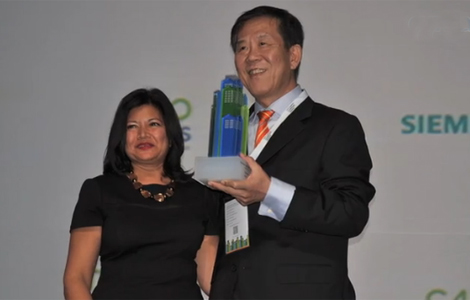Coal-to-gas projects under microscope
Updated: 2014-10-14 03:58
By ZHENG XIN in Beijing(China Daily USA)
|
||||||||
Facing a growing public outcry to do something about choking smog, China has called for acceleration in programs for turning coal in remote areas into gas and then piping it to cities.
However, as cities across China increase their use of natural gas as an alternative to coal, experts are warning of other possible environmental hazards.
Converting to natural gas may clean up the toxic skies of smog, they say, but it will also end up churning out vast amounts of carbon dioxide at a time when the world is struggling to curb greenhouse gas emissions.
"The rapid development of the coal-to-gas projects nationwide would involve a major environmental trade-off in overall carbon emissions while posing a threat to the already fragile ecological environment in western China," said Zhou Shuhui, deputy head of the natural gas pipeline department of the China Petroleum Planning and Engineering Institute, during a seminar held in Beijing on Monday.
"The gas, piped to Beijing and other cities to replace dirtier fuels now used to cook, heat and generate power, would pose an ecological threat to the already fragile environment mostly in remote parts of the country," Zhou said.
Chen Dan, a senior analyst of the China's climate and energy policy project under the Natural Resources Defense Council, echoed her sentiments.
"Coal-to-gas projects are not helping against the global struggle to control carbon emission," said Chen. "The production, transportation and combustion of gas generate more carbon emission compared to coal burning directly and the coal-to-gas plants would not help reduce carbon emissions in the country."
China's State Council called for speeding up the development of the new energy industry last September, moving ahead with the large-scale development of coal-to-gas plants nationwide, mostly in Inner Mongolia and other provinces in the north and west.
Figures released by Green Peace, an independent advocacy organization focusing on environmental protection, there are 50 coal-to-gas projects that are either under construction or going through approvals in China, with 80 percent of them located in the northwestern part of the country, including Xinjiang Uygur autonomous region, Inner Mongolia, Ningxia Hui Autonomous Region and Gansu province.
Using a mix of locally developed and imported technologies, the planned capacity of coal-to-gas in the northwestern part of the country accounts to 72.4 per cent of the national capacity, and more than 80 percent of the plants are owned by the state-owned energy giants, with the remaining 20 percent owned privately.
Seeing coal-to-gas as a green technology that produces far less sulfur dioxide, nitrogen oxide and other pollutants and a solution to urban smog, many experts are in favor of the energy revolution.
Li Zhijian, head of the inorganic chemical industry department of the National Petroleum and Chemical Planning Institute, said the coal chemical industry could achieve the centralized processing and utilization of pollutants and reduce emissions of pollutants.
"It's an important channel to realize the high efficiency and clean use of coal and guarantee national energy security," he said.
The large scale coal-to-gas projects would lead to self-sufficiency in clean energy and further guarantee the country's energy safety, he said.
Tang Hongqing, senior engineer with the Synfuels China, a company focused on coal chemical technology research and development, said that despite the hazards, the project is comparatively the lesser of two evils.
"There is carbon emission for both direct and indirect coal burning, but the new advanced technologies are believed to reduce the hazards of the coal-to-gas projects to their lowest," he said.
Not all experts are so optimistic.
According to a report on China's low-carbon development by Tsinghua University released earlier this year, the lion's share of CO2 will be emitted in the regions where the coal-to-gas plants are located, which are mostly ecologically fragile areas.
Datang's Inner Mongolia Keqi plant — one of two operational pilot projects in China — provides Beijing with 4 billion cubic meters of synthetic natural gas a year through its coal-to-gas operations.
However, the report finds that this contract will reduce Beijing's coal consumption by 9 million tons, but increase Inner Mongolia's by 12 million tons — a net increase of coal consumption of around 3 million tons per year.
This results in a net increase of CO2 emissions of around 3.77 million tons per year.
In addition to the emissions, some experts are also worried about the massive water demands that come along with the processes.
According to Green Peace, about 80 percent of the projects are located in regions with scarce water resources, including Xinjiang Uygur autonomous region and Inner Mongolia, China's largest coal-producing region.
According to the same research from Tsinghua University, the project will increase water consumption in Inner Mongolia by some 24 million tons — a substantial burden for an arid region considered to have a water deficit.
Furthermore, the Keqi coal-to-gas plant's shut down in January for several months due to corrosion problems has also made many less confident that the project actually works.
It's understandable that China views natural gas as a promising avenue for dealing with severe air pollution, but the resulting growth in CO2 emissions could be substantial, said Yang Chi-Jen, a professor at Duke University.
"China should draw lessons from the Great Plains Synfuels Plant that started producing it the 1980s and not to make the same mistakes," Yang said.
The Great Plains coal gasification project has not only become a financial black hole, but also ends up with much air pollution, solid garbage and waste water, he said.
Learning from the experiences of the US, China should take the coal-to-gas projects slowly. Pilot projects in certain regions make more sense than rushing forward by great leaps and bounds, Yang suggested.
zhengxin@chinadaily.com.cn

 China, Russia sign deals on energy, high-speed railways
China, Russia sign deals on energy, high-speed railways
 Chinese art troupe displays power to overcome obstacles
Chinese art troupe displays power to overcome obstacles
 30 most beautiful counties in China
30 most beautiful counties in China
 Largest drum-shaped building in Hefei sets Guiness record
Largest drum-shaped building in Hefei sets Guiness record
 Nixon Remembered
Nixon Remembered
 Premier Li lays wreath at Tomb of the Unknown Soldier
Premier Li lays wreath at Tomb of the Unknown Soldier
 Joint Scorpion venture soars in ratings
Joint Scorpion venture soars in ratings
 Li opens doors on trade, energy
Li opens doors on trade, energy
Most Viewed
Editor's Picks

|

|

|

|

|

|
Today's Top News
Coal taxes could impact market
Shanghai troupe to honor Chinese educator in NYC
High-speed rail deal part of $10b agreements
2nd Ebola patient in US identified
Chinese tourists rank US 3rd
Future of US-China movies to be discussed
Chinese song video viral
Scorpion venture soars in ratings
US Weekly

|

|







